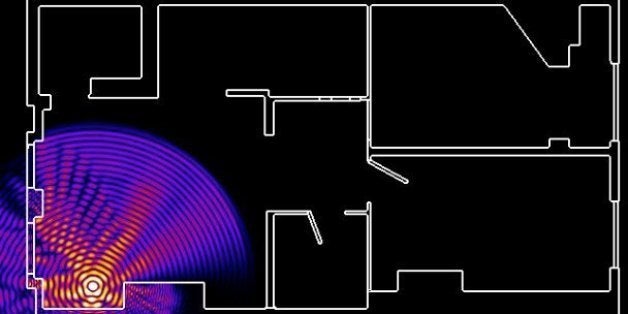We've all felt that agonizing moment of WiFi-lessness when the connection drops out unexpectedly. Turns out, there's a right and wrong way to set up a WiFi router, and the wrong way can leave you waiting longer for pages to load or Netflix to buffer.
Jason Cole, a PhD student in physics at Imperial College London, used math to figure out the best spot to place a wireless router. Cole solved the Helmholtz equation -- which is used to map electromagnetic fields like the ones your router emits -- for his apartment. What he discovered was that tucking a router away in an inconspicuous corner is not ideal for a good connection, even though that's the way most of us do it.
Speaking with The Huffington Post, Cole offered a number of tips to help your WiFi router send a strong signal all over your home or apartment and reduce the amount of Netflix buffering you have to sit through.
1. Place the router in a central location.
We know the wires you plug into the router are probably set up in the corner of the room, but it's better to run them over to a more central spot. Ideally, it'll be within sight of wherever you sit and use the Internet most.
Here's what your WiFi setup is probably like right now:

In this illustration, the WiFi signals are actually traveling from the router throughout the entire apartment in about one ten-millionth of a second. You can see how the signal bounces off walls to fill a room with delicious Internet. Dead zones, where the signal doesn't quite reach, are also visible and become more common further from the source, as walls and other obstacles absorb more signal energy.
2. Avoid surrounding it with metal objects.
"Metal dissipates electromagnetic energy quite efficiently," Cole told HuffPost in an email. So the kitchen is not the best place for your router to live.
3. Concrete or brick walls are the enemy, too.
"All materials reflect a portion of radiation. Some absorb it quite strongly, especially concrete," Cole said. Enclosing the router with concrete or brick on a couple sides won't help your signal reach the furthest corners of your home.
Additionally, floors and ceilings tend to be more transmissive than walls, Cole noted.
4. Don't keep the router near a microwave.
If you've noticed the Internet slowing down whenever you're heating something up in the microwave, it's not just you. Microwaves operate around the same frequency as wireless routers, and even the tiny bit of radiation that escapes the microwave can disrupt your signal.
WiFi routers emit radio waves, which spread out and down from their source. Mounting the router to a wall or setting it on a high shelf can give you a better signal, especially if you live in a two-story house and want a good connection on both floors.
6. Position the antenna upward for a better horizontal reach, or sideways for vertical reach.
In a multi-story home, positioning a router's antenna sideways can help you get a better signal upstairs. Pointing an antenna up helps the router reach farther laterally.
If your router has two antennas, though, take care of all possibilities by pointing one antenna up and the other to the side. And if you've got a router without any antennas, make sure you stand it the way it's made to go. That is, don't lay a vertical router on its side.
7. Think twice about putting a router somewhere with a lot of people.
Water inhibits WiFi signals. Since humans are mostly water, a bunch of us hanging out in a room together can interfere with the signal. You may have noticed getting worse Internet connections in crowded spaces. And yes, you probably want a good WiFi signal in the room where people like to gather, but all those bodies might slow it down in other parts of the house.
BONUS: Use Cole's app, which lets you visualize the WiFi connection in your own house.
If you're so inclined, Cole created an app for Android phones that lets you upload a floorplan to see how electromagnetic waves propagate throughout your own home. (Some math required. Sorry.)
Our 2024 Coverage Needs You
It's Another Trump-Biden Showdown — And We Need Your Help
The Future Of Democracy Is At Stake
Our 2024 Coverage Needs You
Your Loyalty Means The World To Us
As Americans head to the polls in 2024, the very future of our country is at stake. At HuffPost, we believe that a free press is critical to creating well-informed voters. That's why our journalism is free for everyone, even though other newsrooms retreat behind expensive paywalls.
Our journalists will continue to cover the twists and turns during this historic presidential election. With your help, we'll bring you hard-hitting investigations, well-researched analysis and timely takes you can't find elsewhere. Reporting in this current political climate is a responsibility we do not take lightly, and we thank you for your support.
Contribute as little as $2 to keep our news free for all.
Can't afford to donate? Support HuffPost by creating a free account and log in while you read.
The 2024 election is heating up, and women's rights, health care, voting rights, and the very future of democracy are all at stake. Donald Trump will face Joe Biden in the most consequential vote of our time. And HuffPost will be there, covering every twist and turn. America's future hangs in the balance. Would you consider contributing to support our journalism and keep it free for all during this critical season?
HuffPost believes news should be accessible to everyone, regardless of their ability to pay for it. We rely on readers like you to help fund our work. Any contribution you can make — even as little as $2 — goes directly toward supporting the impactful journalism that we will continue to produce this year. Thank you for being part of our story.
Can't afford to donate? Support HuffPost by creating a free account and log in while you read.
It's official: Donald Trump will face Joe Biden this fall in the presidential election. As we face the most consequential presidential election of our time, HuffPost is committed to bringing you up-to-date, accurate news about the 2024 race. While other outlets have retreated behind paywalls, you can trust our news will stay free.
But we can't do it without your help. Reader funding is one of the key ways we support our newsroom. Would you consider making a donation to help fund our news during this critical time? Your contributions are vital to supporting a free press.
Contribute as little as $2 to keep our journalism free and accessible to all.
Can't afford to donate? Support HuffPost by creating a free account and log in while you read.
As Americans head to the polls in 2024, the very future of our country is at stake. At HuffPost, we believe that a free press is critical to creating well-informed voters. That's why our journalism is free for everyone, even though other newsrooms retreat behind expensive paywalls.
Our journalists will continue to cover the twists and turns during this historic presidential election. With your help, we'll bring you hard-hitting investigations, well-researched analysis and timely takes you can't find elsewhere. Reporting in this current political climate is a responsibility we do not take lightly, and we thank you for your support.
Contribute as little as $2 to keep our news free for all.
Can't afford to donate? Support HuffPost by creating a free account and log in while you read.
Dear HuffPost Reader
Thank you for your past contribution to HuffPost. We are sincerely grateful for readers like you who help us ensure that we can keep our journalism free for everyone.
The stakes are high this year, and our 2024 coverage could use continued support. Would you consider becoming a regular HuffPost contributor?
Dear HuffPost Reader
Thank you for your past contribution to HuffPost. We are sincerely grateful for readers like you who help us ensure that we can keep our journalism free for everyone.
The stakes are high this year, and our 2024 coverage could use continued support. If circumstances have changed since you last contributed, we hope you'll consider contributing to HuffPost once more.
Already contributed? Log in to hide these messages.



